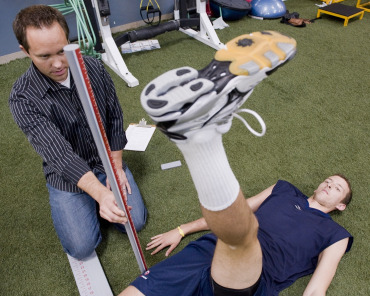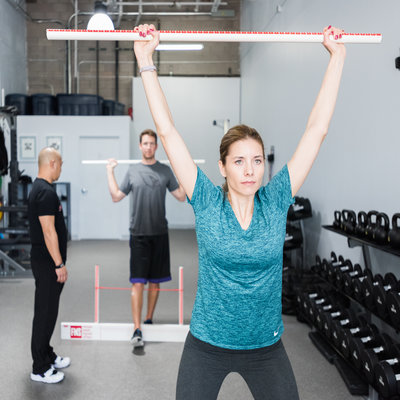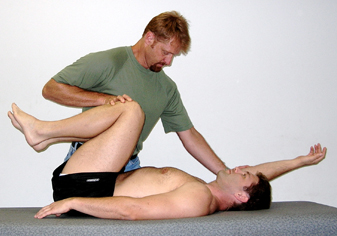FMS Screening and Physical Limitations
Written by Gray Cook FMS
We often get screening questions from people who have clients who can’t do a test because of a physical limitation. For example, there was a man on my Facebook page who asked about this; he couldn’t do the rotary stability test because his stomach got in the way.
What if someone is missing an arm? What if somebody has a deformity? What if somebody has a large, protruding belly and is unable to do one of the tests?
Let me make it really simple: You’re the professional. Modify the program, not the screen.
This means don’t obsess on adjusting a score. If somebody can’t do the quadruped diagonal pattern because the belly is in the way or because the upper body is too tight, it doesn’t matter. The score is the score. The screen is blind.
The screen only says a person cannot move in a pattern. The reason doesn’t matter on the screen, but it should matter in your programming. Modify your programming with the things you know that none of the rest of us can know about your client.
 We go into this in great detail in the forthcoming Future of Exercise Programming DVD Lee and I shot with Alwyn Cosgrove. The DVD is due out in October.
We go into this in great detail in the forthcoming Future of Exercise Programming DVD Lee and I shot with Alwyn Cosgrove. The DVD is due out in October.
You are the professional on the ground, and you need to work with the information available to you. You can choose to attack one of the patterns the screen exposes to be deficient, or choose not to. Don’t keep trying to modify the screen or make the screen see things it wasn’t designed to see.
The reason we screen is we’re going to be giving exercise suggestions. If your quadruped diagonal pattern is limited by your belly and mine is limited by my flexibility, let’s agree that if the pattern looks like any of the exercises we’re planning, there’s probably going to be a lot of compensation.
The reason you compensate or have difficulty doesn’t matter at the screening stage.
Don’t try to modify the screen or throw people scores they don’t deserve. The reason they may not be able to change that score could be a structural problem, or something else. Let the screen expose the movement profile. Let it be what it is, and modify your programming to match.
I see patients with certain movement patterns that, because I have knowledge outside of the screen, I may choose to ignore one of the patterns. I continually check to see if it changes, but there may be a total joint replacement, a previous surgery or another reason for limited potential of improvement in one pattern.
 I take it off the grid in the programming, but I still let the screen say what it says. That’s really the advice I give. We waste a lot of valuable time asking ‘What if? What if? What if?’
I take it off the grid in the programming, but I still let the screen say what it says. That’s really the advice I give. We waste a lot of valuable time asking ‘What if? What if? What if?’
We have personal trainers working with clients who have had strokes. These people are often considered disabled in some way, especially if they have an assistive device or walk with a serious gait deviation. You’re welcome to screen on them. What are the first two tests we do? Active straight leg raise and shoulder mobility. You may not want to do anything more than that.
When we have an evaluation that has been done for a medical limitation or a structural abnormality, it trumps whatever the movement screen says. If the movement screen in some way disagrees with a medical diagnosis or evaluation, there’s a good chance you used the screen inappropriately.
Most people who are severely limited yet wish to exercise or participate in an activity are going to have difficulty just getting a score of ‘2’ on the active straight leg raise or shoulder mobility. You have plenty of programming right there. You don’t need to take a stroke client through a deep squat. It’s not even close to the weakest link.
Don’t expect a test to modify itself to every situation. You choose and modify the programming to accommodate the other information you should collect in addition to the movement screen.
 Now let’s consider the next question we usually get: How important are body proportions as a factor?
Now let’s consider the next question we usually get: How important are body proportions as a factor?
Let’s use the example of the overhead squat. Maybe the way one person is built, he needs more ankle flexion and has more of a forward lean in the deep squat than another person. Because he leans forward more at the hip, he wants to know if he needs more thoracic extension or more shoulder flexibility to keep the bar over his feet.
This is where the person asks if we can cut a little slack if the stick isn’t over his feet or if his upper arms are over his ears. Is the screen self-adjusting or does he just have to work a little harder?
Look, I cut no slack, but just to make things fair, I don’t cut myself any slack either.
I’m always going to struggle with a perfect overhead squat. I’m 6’4” and weigh 250 pounds. I’ve broken both ankles twice. I’m pretty long-legged compared to torso length. If I invented the screen and I’m not going to cut myself any slack, I’m sure not going to dole it out to anybody else.
Here’s what I will tell you… again: It’s simply a screen.
This is probably most important point you’ll ever get from me when it comes to the Functional Movement Screen. There’s perfection; there’s imperfection; there’s dysfunction.

A score of ‘3’ on the movement screen demonstrates close to perfection. I would want to use you for a textbook demonstration of what this pattern looks like at its best.
A score of ‘2’ means an imperfection. You passed the test, but there’s room for improvement. You may have an anatomical proportional reason or a training or other problem that keeps you from the ‘3.’
Continue working on it because if I were able to improve the deep squat at all, you have to admit there’s room for improvement. Letting you blame 100% of your lack of overhead squatting ability on your proportions in anatomy absolves you from exploring corrective strategy and trying to improve it.
Will I be able to promote you as the best overhead squatter at Cirque du Soleil in Vegas? Probably not. Would you have about 25% improvement potential if you were to do some of the corrective strategies? Maybe!
But don’t obsess over that squat if you don’t have ‘2s’ on everything and no asymmetries anywhere in the screen. The squat problem is demonstrated further down the developmental chain, maybe in your active straight leg raise or thoracic spine mobility. Many people want to peg a ‘3’ on the squat without preparing the body for the squat.
The squat is the last thing that we fix.
Finally, we come to dysfunction. That means you have a ‘1’ somewhere on the screen.
If you get imperfection across the board on the Functional Movement Screen, I don’t consider you dysfunctional. Don’t consider ‘2s’ as failure. A ‘2’ is average. Because of your proportions, training and previous injuries, a ‘2’ may be the pinnacle you’ll reach.
However, if you have a ‘1,’ that’s dysfunction. Whether you have a lot of excuses or none, it’s a potential risk factor even if you do exercises perfectly.
Let’s recap. You don’t have to be perfect on everything. You can be imperfect and still not be at an elevated risk of injury.
Then there’s dysfunction. There are too many people splitting hairs about perfection versus imperfection while dysfunction walks by and gets on the pec-dec at the gym.
Where I see a lot of the other assessments and functional tests nitpicking the differences in perfection and imperfection, my life’s work has been, ‘Please, before you throw exercises and load at people, identify those who have true dysfunction.’
 The people who need your help the most, the people who train and are still obese, and the people who work hard and still get injured are probably walking around with a couple of ‘1s’ on their movement screens. They haven’t met the person who cares enough to intervene.
The people who need your help the most, the people who train and are still obese, and the people who work hard and still get injured are probably walking around with a couple of ‘1s’ on their movement screens. They haven’t met the person who cares enough to intervene.
You have some imperfections in your overhead squat. My first thought is I bet it’s not your only imperfection. Look at the rest of your screen, honestly look. See where you have asymmetries and dysfunctions and clean those up to ‘2s’ on everything with no asymmetries before you squat.
Then start working on your squat. If you improve it 25%, you can’t blame anatomy and proportions for a poor score. You had some room for improvement, which is my whole point. Will you ever achieve perfection? No, it’s not even possible—what is perfection in movement? But there’s probably room for improvement.
There is enough of a buffer zone built into these tests that allow for body proportions such as a longer-than-average femur length. There are enough other segments that can do a little more or a little less elsewhere in the body.
Remember, the American Medical Association has produced goniometric measurements referring to the degrees each of the joints should move. Not one test on the Functional Movement Screen asks more than that.
Most of the debates people get into about the Functional Movement Screen are about perfection and imperfection, while dysfunction gooses through everywhere. Check for a dysfunction first and you’ll be a better trainer.
I could split hairs in the gym all day long and not make a difference. Once I started following the FMS model, I could change lives. It’s the most rewarding thing in the world.
Lee and I go into this in great detail in our two-day Perform Better FMS Workshops, coming up in Rhode Island, Los Angeles, Chicago and Charlotte, NC.
You can also learn on your own by reading Movement. In fact, I encourage you to read Movement before attending an FMS workshop. You’ll get more out of it.
Related Resources
-
FMS Combine Review
Posted by Lee Burton and Jon Torine
-
The Momentum of Perspective
Posted by Gray Cook
Please login to leave a comment
3 Comments
-

Paul 12/18/2014 7:03:58 PM
Wise words. I'm on the FMS online course following an RTA and a screen by a good physio who gave me great programming. Next i'm on a physio degree because I'm very dysfunctional when it comes to splitting hairs too!
There's obviously a place for me with all this talk of NOT helping your clients. Wake up dull physicians!
Life is an interesting journey. Be an FMS expert to smooth the ride. : )
You can end up driving the bus for folks too.
(You need the books first - I bought them second which is why I failed by two split hairs.)
-

Sonja Viljoen 12/18/2014 7:16:15 PM
Very helpful to reiterate the focus on dysfunction rather than imperfection and perfection.
-
Philip Deer 3/8/2018 10:31:37 AM
FMS for Pre & Post Natal Is it safe and/or appropriate to use the FMS to screen movement for clients during any part of their pregnancy or immediately post-partum? My instinct is that it's not appropriate during because of increase risk of injury while performing the screen and the body is not the same, so the standards of what is acceptable movement is not the same. Also, post-partum, my instinct is that it's not appropriate because of the trauma the body just went through and it needs time to heal and recover before being subject to the same standards/screen. Please share what its best practice for this as I want to do the best on their behalf to keep them safe and optimize their performance for delivery while returning to a pain-free body with good movement post-partum. Thanks in advance!





